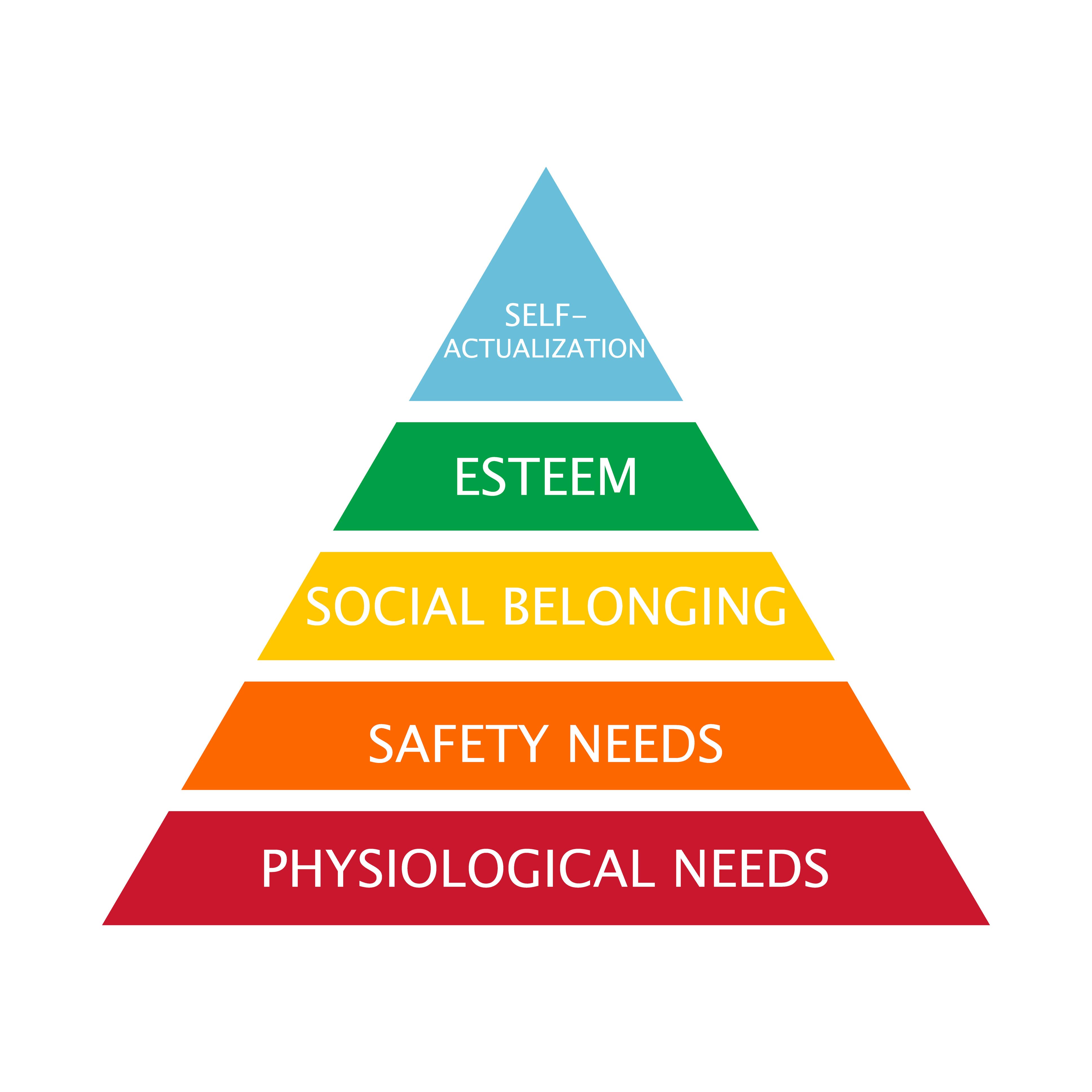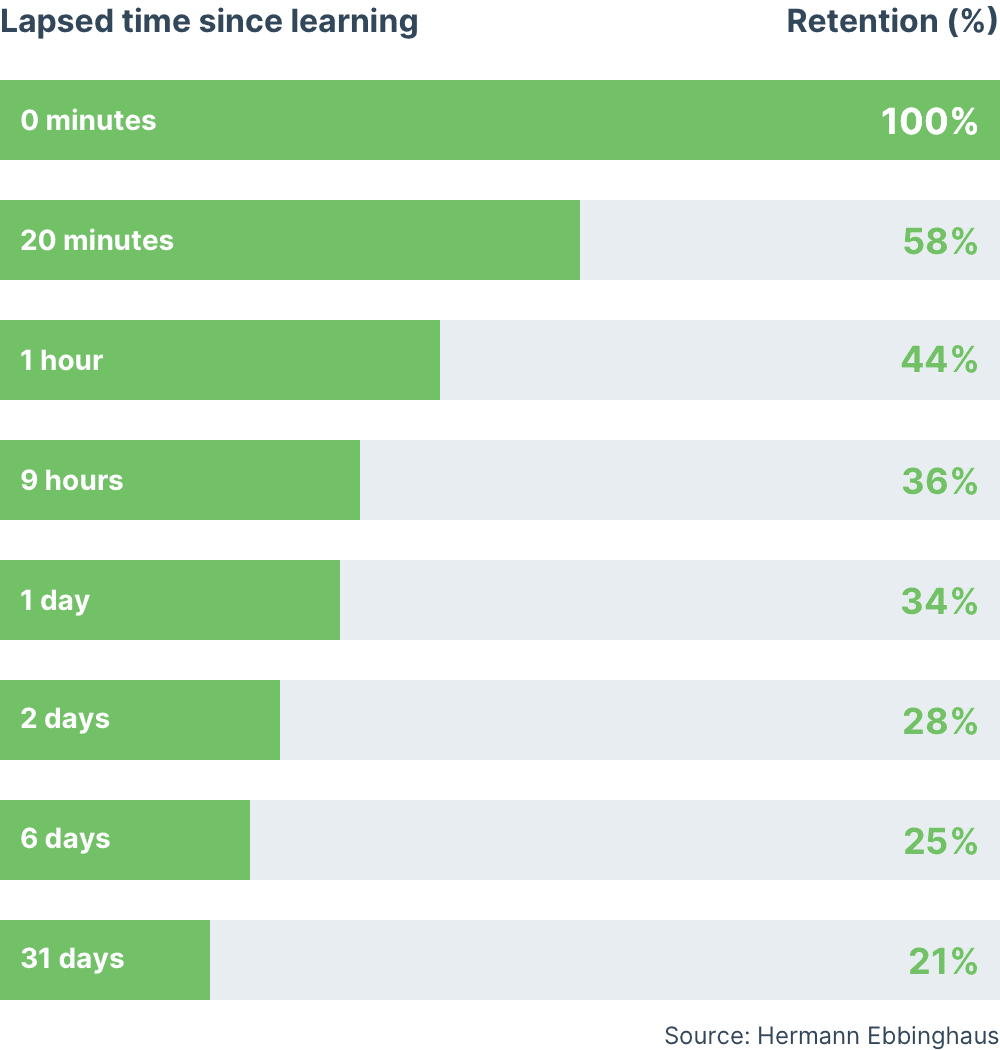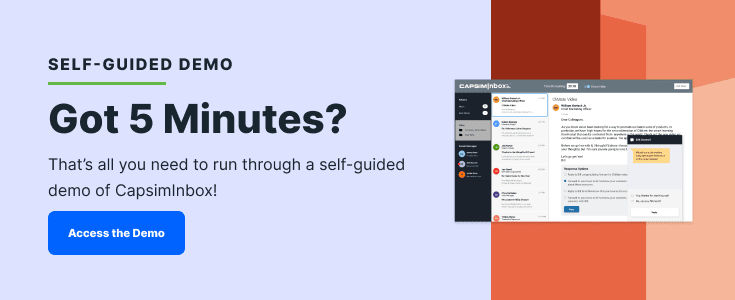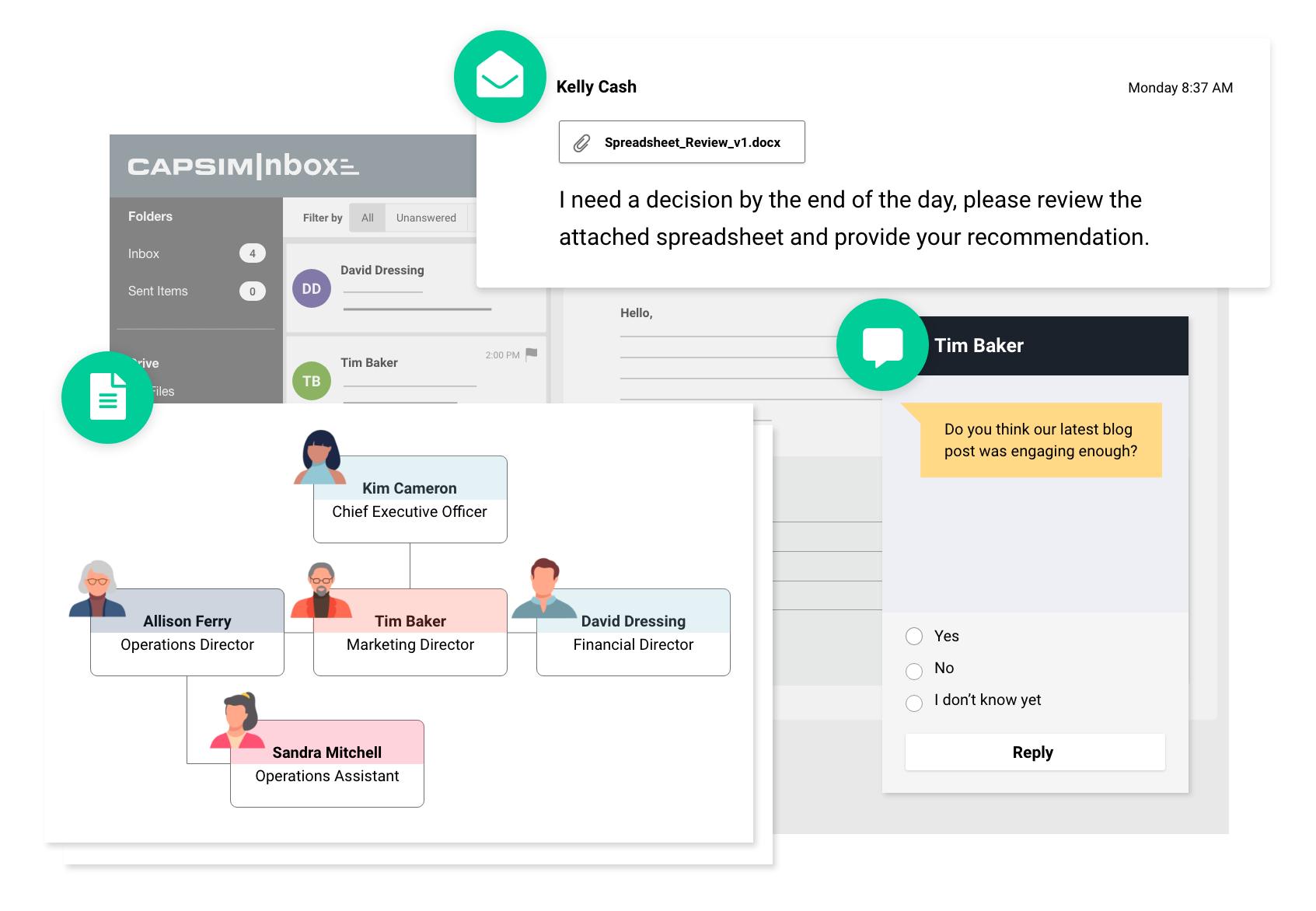How to Maximize Corporate Learning and Development ROI with Simulations
December 1, 2021

As the saying goes, “What gets measured gets improved.”
And according to LinkedIn’s 2021 Workplace Learning Report, learning and development leaders worldwide have set lofty expectations.
The top three focus areas from the 1,260 L&D professionals surveyed were the following:
- Upskilling and reskilling - 59%
- Leadership and management - 53%
- Virtual onboarding - 33%
Given the importance of these improvement areas to your company's success, it's more critical than ever to ensure your learning and development opportunities are effective. What’s more, you must show progress to key performance indicators (KPIs) and demonstrate return on investment (ROI).
Simulation-based learning is a tool that can help you achieve both of these goals. This post will show why simulations are instrumental in meeting numerous different KPIs and nurturing a culture of continuous improvement in your company.
7 Corporate Learning & Development KPIs Simulations can Positively Influence
Measuring the ROI of your corporate learning and development program can be tricky. There’s no universal standardized method for measuring ROI, and there are dozens of factors to consider, including company size, type, and objectives.
Most organizations use a handful of KPIs to measure progress and calculate the ROI of their L&D efforts. These KPIs are focused on measuring the effectiveness of L&D efforts and their impact on the organization. Therefore, using the right tools and instructional methods is key for L&D leaders as they look for ways to positively impact their company, and by association, their employees.
Simulation-based learning offers numerous benefits. We’ll examine these benefits in the context of the exact KPIs that are most impacted by interactive, simulation-based training.
1. Employee engagement
Recent studies indicate that only a third of employees feel engaged or motivated to contribute toward company goals and objectives. Gallup found in a 2017 study of employee engagement that companies in the top percentile of employee engagement see:
- 41 percent decrease in absenteeism
- 17 percent increase in productivity
- 24 percent less turnover in high-turnover organizations
- 59 percent less turnover in low-turnover organizations
- 21 percent greater profitability
Put simply, engaged employees stick around longer and have a greater positive impact on the organization. But what factors influence employee engagement, and what role does learning and development play?
In many cases, executive teams look at employee engagement as a metric that can be moved through compensation, benefits, and bonuses or rewards. While that may work for some employees, it is superficial; money and company outings will only go so far in a compromised work culture.
Far more valuable is looking at how your organization helps fulfill your employees' need for belongingness, a sense of accomplishment, and self-actualization.

A great company culture and hitting organizational goals help address psychological needs like relationships, friendships, and feeling accomplished. But even more valuable is L&D’s role in helping employees with self-actualization and achieving their full potential.
L&D’s goal is to help employees level-up their skills and become the best versions of themselves, and that’s where simulations are a useful tool.
Simulations like CapsimInbox can be customized to specific skills and roles, increasing their relevance and helping your employees progress in skills they’ll use in their jobs. Simulations also offer the ability for progress measurement over time. Progress and improvement are key in keeping employees engaged in their jobs and career development.
2. Retention/attrition of top employees
Of course, if employees aren’t engaged and don’t feel like their company is giving them the tools to better themselves, they may leave.
According to LinkedIn’s Workplace Learning Report 2019, 94 percent of employees say they would stay at a company longer if there is investment in their learning and development. In the battle for top talent, a top-tier L&D program focused on helping employees improve is just as important as traditional benefits packages. Again, customizable simulation-based learning can prove fruitful.
In a recent article, we laid out how we would structure a development program using simulations. Part of that program is the creation of unique individual development plans for each employee.
After using simulations to gather a skills baseline and identify possible skills gaps, a conversation with an employee around their long-time professional interests and goals would help you tailor a plan to the employee. Combining simulations with other learning tools can help them grow their skill proficiency and increase job performance over time.
This personal interest in each employee can also make it easier to spot potential for advancement. Simulations can be used as an assessment tool to build a leadership pipeline and train the necessary skills for first-time leaders in your company.
It’s one thing for employees to feel like you’re invested in their learning and development. But backing it up with relevant and engaging opportunities aligned with their goals reinforces your investment and can keep talented people from looking for other opportunities.
RELATED READING: Seven Steps to Retain Your Employees [that aren't obvious]
3. Time to proficiency
How quickly can new employees get up to speed and perform at a high level?
Time to proficiency is a key metric that illustrates the effectiveness of our L&D program. And while slow and steady was fine for the tortoise, you need to be like the hare. The market moves fast, and your L&D program can’t positively impact your company’s success if it takes months for employees to skill up.
The bad news here is that companies are often getting in their own way. According to Dr. Raman K. Attri, many companies make one or more of the following critical mistakes that increase time to proficiency:
- Inefficient training program design. An over-reliance on typical “academic ways” of learning that focus on memorizing facts and patterns without a path for knowledge application.
- Rigid and non-scalable learning methods. Because of the time-intensive nature of inefficient training programs design, employees get the same one-size-fits-all training.
- Content-heavy learning methods. Dozens of PowerPoints and presentations littered with irrelevant and "just in case" content bloats training programs and increases the burden on employees to remember all the information.
- Instructor-centered learning. An instructor delivers information in one-way classroom lectures without offering an avenue for applying the knowledge dispensed. This is a root cause of low knowledge retention leading to employees who never reach desired skill proficiency.
- Overly topic or task-focused learning. The mistake here is focusing too much on the delivery method instead of how to do a particular job. The typical outcome is a thick three-ring binder full of task processes that employees must constantly refer to.
The common thread across all these mistakes is a lack of focus on how employees learn, gain skills, and retain knowledge. Your employees need to experience all three levels of learning:
- Gaining knowledge.
- Knowing how to apply that knowledge.
- Applying the knowledge in a life-like situation.
Your employees need quality repetitions. Professional football teams combine film sessions and drills to prepare for in-game situations. Helping employees achieve an ideal level of job performance requires the same approach.
Simulations are based on real-life situations and delivered in a safe, risk-free digital environment. This allows your employees to achieve quality reps faster than classroom lectures, instructor-led training, or role-playing sessions.
4. Knowledge and skill retention
Have you ever forgotten someone’s name five minutes after you met them? We all have, and it’s because humans are really good at forgetting vital information.
In the late 1800s, a German psychologist named Hermann Ebbinghaus conducted a study around human forgetfulness. He found that unless we apply the new information we’ve learned, we’ll forget 75 percent of it in less than a week.

The key part of that last sentence is “unless we apply the new information we’ve learned.” Influencing knowledge and skill retention metrics is incredibly difficult without an avenue for knowledge application.
Knowledge and skill retention is a result of putting an employee in a real-world situation, sifting back through their knowledge, and applying it to make a decision or take an action that gives them immediate feedback. As noted above, many L&D programs make the mistake of not using development tools that offer a chance for knowledge application.
But simulation platforms like CapsimInbox do. Employees go through a whole day’s worth of decisions and situations in less than 30 minutes. They see the direct impact of the decisions they make through consequences or rewards delivered in the simulation.
And since learning is delivered in micro-doses, simulations can be deployed at a higher frequency to keep lessons learned fresh in the minds of your employees.
5. Transfer of training
Transfer of training involves employees taking concepts, knowledge, and skills learned in training and applying them to their jobs. It is a pertinent KPI for measuring training effectiveness, job performance, and outcomes.
More specifically, transfer of training is applying knowledge acquired to make one decision to solve a similar problem. For example, an employee can take project management skills learned in a college course and apply them to the first project they oversee in their job.
An L&D department’s purpose in this sense isn’t to try and prepare employees for every different situation they may encounter. There aren’t enough days in the calendar for that type of training. The goal is to give them the foundational skills needed to think critically and navigate the unique factors of each situation.
With simulations, the real-world scenarios your employees go through prepare them for the situations they encounter in their jobs. Simulations can also help employees build vital soft skills like critical thinking and problem-solving. When they encounter a unique situation in their work, they can work through it and develop a solution.
6. Learner satisfaction
Do your employees enjoy their development opportunities? Do they look forward to learning? Do they see it as a valuable use of their time?
Learner satisfaction may not seem as important as some of the others we’ve covered here. However, keeping a pulse on how favorably or unfavorably employees feel about their development opportunities is important. A well-liked and respected L&D program is central to increasing employee engagement and building a culture of continuous development.
Simulations offer benefits on this front as well. They are gamified, life-like stories that are told or played from the employee’s point of view and deliver immediate performance feedback. This type of learning helps employees see themselves in the story, increases the stakes, and ingrains learning deeper than lectures or PowerPoints can.
7. Operational performance metrics
What effect does learning and development have on your company’s performance metrics?
The whole purpose of your L&D department is to help employees achieve their full potential and push the company forward. If your company tracks operational metrics, you can look at them through the lens of performance before certain L&D initiatives started and performance since.
For example, many companies use Net Promoter Score, or NPS, as a performance measure. NPS scores are measured by a customer’s response of 1-10 to the following question: How likely are your customers to recommend you to a coworker or colleague? It’s a measure of customer experience, and is crucial to referrals and word-of-mouth business.
So what goes into delivering a great customer experience?
- Clear, fast, and proactive communication
- Solving issues quickly and completely
- Thinking outside the box to solve complex problems
- A pleasant and positive attitude
- Listening attentively and asking the right questions
Short of role-playing sessions, how else can your employees get reps to build these skills?
Real-world situations delivered through simulations offer employees the chance to make decisions and understand the outcomes of their choices in a risk-free environment. Through simulation training, soft skills like critical thinking, problem-solving, and clear communication can be taught, learned, and refined.
Maximize Corporate Learning and Development ROI with CapsimInbox
As we like to say, athletes need drills, scrimmages, and performance feedback. Your employees do, too. CapsimInbox doesn’t need to be your only tool, but we believe it would be a valuable addition to your L&D toolbox.
Why? Because For any learning solution to truly promote ongoing skill development, it must meet four criteria:
- Incorporate both knowing and doing
- Foster accurate self-awareness
- Deliver an engaging and relevant experience
- Provide actionable feedback
If any simulation solution you’re considering doesn’t meet these criteria, you could be wasting your L&D budget. We want you to make the best choice possible, so we compiled other considerations in our ebook, “7 Questions to Ask Before Investing in Simulations.”
Once you understand the importance of these seven questions, you'll be able to confidently select the simulation platform that:
- Aligns with your required learning objectives.
- Offers a way to assess knowledge application.
- Assesses and develops business-critical soft skills.
- Fits your budget.
- Your learners will actually look forward to using.
Another good next step is our self-guided inbox simulation demo. In as little as 5 minutes, you can experience our engaging learning environment and see what your employees would see.





.png?width=80&name=1-questions%20(1).png)